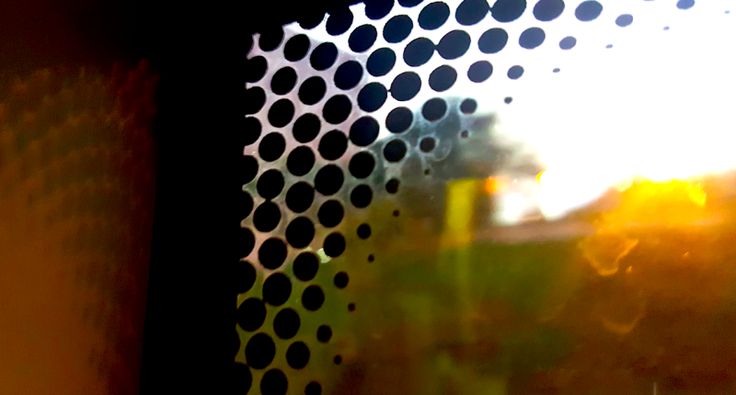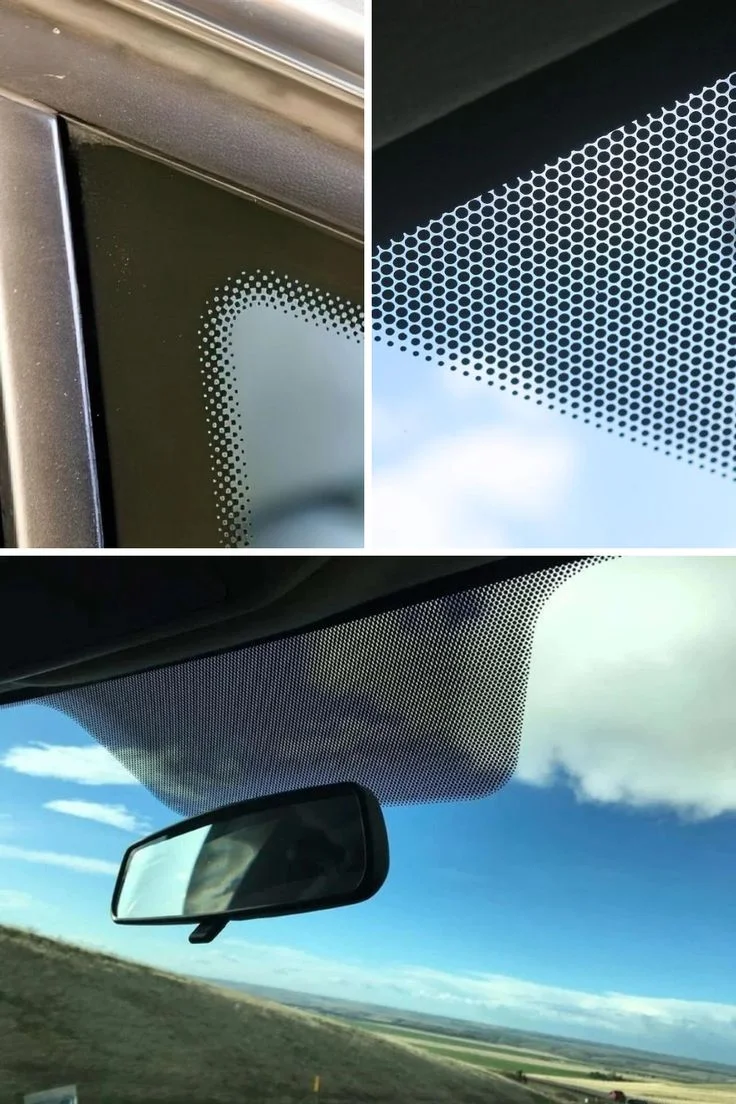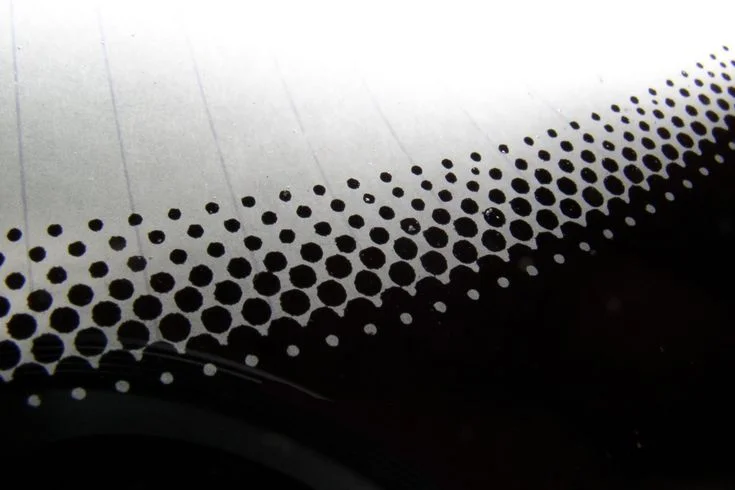Here's a mind blowing fact: 94% of drivers have never questioned those tiny black dots around their windshield, yet these microscopic ceramic warriors are working overtime to keep you safe and comfortable every single day.
You glance through them thousands of times without realizing they're one of the most ingenious automotive safety features ever created.
Those seemingly decorative speckles dotting your windshield's perimeter? They're called ceramic frit, and they're about to completely change how you see your car windows.
The $36 Billion Secret Hidden in Plain Sight
Walk up to any car and you'll spot them immediately. Those perfect little black dots gradually decreasing in size as they fade from the solid black border into clear glass. Most people assume they're purely aesthetic, maybe some designer's fancy touch to make windshields look more sophisticated.
"I always thought they were there to make the car look nicer," admits Sarah Chen, a mechanical engineer who drives a 2019 Honda Accord. She's not alone. Automotive surveys reveal that an overwhelming majority of drivers have zero clue about their windshield's dot matrix system.
The global automotive glass market, valued at $36.48 billion in 2024, depends heavily on this ceramic frit technology. Yet somehow, this critical safety feature remains one of the industry's best-kept secrets.
Your Windshield's Invisible Bodyguard System
Here's where things get fascinating. Those dots aren't decorative at all, they're a sophisticated engineering solution baked directly into your glass during manufacturing at temperatures exceeding 1,200°F.
Ceramic frit serves three crucial functions that could save your life:
1. UV Protection That Never Sleeps
The black ceramic material acts as a permanent sunscreen for your windshield's adhesive. Without this protection, ultraviolet rays would systematically degrade the polyurethane adhesive bonding your windshield to the car frame. Beam Auto Glass explains that this UV degradation could eventually cause complete windshield failure, imagine your windshield popping out during an accident because the adhesive deteriorated over time.
2. Temperature Distribution Mastery
This is where automotive engineering gets brilliant. The solid black band heats up much faster than clear glass when exposed to sunlight. Without the dot gradient system, you'd have a dangerous temperature differential between scorching hot edges and cooler centers. Hackaday's technical analysis reveals that this temperature difference could cause optical distortion or even crack your windshield.
The dots create a smooth thermal transition, preventing what engineers call “lensing”, optical distortion that could literally warp your view of the road ahead.
3. Structural Integrity Enhancement
Those tiny dots provide a textured surface that dramatically improves adhesive bonding strength. The ceramic material gives the polyurethane adhesive something substantial to grip onto, creating a mechanical bond that's far superior to smooth glass alone.
The Manufacturing Marvel You Never Noticed
Creating ceramic frit involves a precision process that would make a Swiss watchmaker jealous. During windshield manufacturing, ceramic paint containing metallic oxides gets silk-screened onto the glass in an exact dot pattern. The glass then enters specialized ovens where temperatures reach extreme levels, permanently fusing the ceramic material into the glass structure.
This isn't some aftermarket addition, it's integral to modern windshield design. The dot pattern follows specific mathematical algorithms to ensure optimal heat distribution and visual aesthetics.
Why Your Grandfather's Car Didn't Need This Technology
Older vehicles used completely different windshield attachment methods. Cars from the 1950s and 1960s relied on metal trim and rubber gaskets to hold windshields in place. While this looked clean and polished, it had a terrifying flaw: windshields could easily pop out during accidents, turning them into deadly projectiles.
The automotive industry's shift to direct adhesive bonding created the need for UV protection, spawning the ceramic frit innovation we see today. Modern crash safety standards would be impossible to meet without this technology.
The Optical Illusion Effect
Here's something that'll make you do a double-take on your next drive. The dot matrix pattern creates a subtle optical illusion that helps your eyes transition smoothly from the tinted border to clear viewing area. Without this gradient effect, you'd experience jarring visual transitions every time you looked through different parts of your windshield.
"It's like automotive camouflage," explains Dr. Michael Rodriguez, an optical engineer who has studied automotive glass systems. “Your brain processes the gradual transition so smoothly that you're not consciously aware it's happening.”
The Mirror Magic Most People Miss
Look closely at the area around your rearview mirror. See those dots? They're specifically designed to reduce glare and heat buildup in that critical viewing zone. This targeted application prevents the mirror mounting area from becoming a concentrated heat spot that could affect adhesive performance or driver comfort.
Some manufacturers even customize dot patterns behind mirrors to accommodate different electronic sensors and cameras integrated into modern vehicles.
When Ceramic Frit Goes Wrong
Professional auto glass technicians know that improper frit application can create serious problems. If the ceramic material isn't applied correctly or gets damaged during installation, you might experience:
- Premature adhesive failure
- Increased glare and heat penetration
- Compromised structural integrity
- Optical distortions in peripheral vision
"I've seen windshields fail because someone tried to save money with substandard frit application," warns Tom Mitchell, a certified auto glass installer with 15 years of experience. “Those little dots are not something you want to cheap out on.”
The Future of Windshield Technology
Advanced automotive manufacturers are already experimenting with smart frit systems that can change opacity based on lighting conditions. Some luxury vehicles incorporate heating elements directly into the frit pattern, creating defrosting capabilities that extend beyond traditional heated windshields.
Electric vehicles are driving innovation in this space, with some manufacturers developing frit patterns optimized for solar panel integration and enhanced aerodynamics.
Your Daily Dose of Automotive Genius
Next time you settle into your driver's seat, take a moment to appreciate those tiny black dots. They represent decades of engineering innovation, millions of dollars in research and development, and the kind of invisible safety features that make modern driving possible.
You're looking through one of the most sophisticated pieces of automotive technology ever created, and it's been hiding in plain sight all along. Those microscopic ceramic guardians are working 24/7 to keep your windshield exactly where it belongs - firmly attached to your car, optically perfect, and protecting you from whatever the road throws your way.



Comments (0)
Please login to join the discussion
Be the first to comment on this article!
Share your thoughts and start the discussion